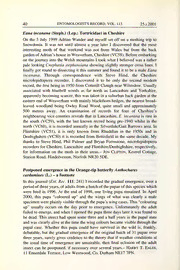
Eana incanana (Steph.) (Lep.: Tortricidae) in Cheshire PDF
Preview Eana incanana (Steph.) (Lep.: Tortricidae) in Cheshire
40 ENTOMOLOGIST'S RECORD, VOL. 113 25.i.2001 Eana incanana (Steph.) (Lep.: Tortricidae) in Cheshire On the 3 July 1999 Adrian Wander and myself set off on a mothing trip to Snowdonia. It was not until almost a year later I discovered that the most interesting moth of that weekend was not from Wales but from the back garden ofAdrian's house in Weaverham, Cheshire (VC58). Before embarking on the journey into the Welsh mountains I took what I believed was a rather pale looking Cnephasia stephansiana showing slightly stronger cross lines. I finally got round to dissecting it this summer and found it to be a male Eana incanana. Through correspondence with Steve Hind, the Cheshire microlepidoptera recorder, I discovered it to be only the second modern record, the first being in 1950 from Cotterill Clough near Wilmslow. Usually associated with bluebell woods as far north as Lancashire and Yorkshire, apparently becoming scarcer, this was taken in a suburban back garden at the eastern end of Weaverham with mainly blackthorn hedges, the nearest broad- leaved woodland being Owley Road Wood, quite small and approximately 500 metres away. An examination of records for four of Cheshire's neighbouring vice counties reveals that in Lancashire, E. incanana is rare in the south (VC59), with the last known record being pre-1940 whilst in the north (VC60), it is recorded annually in the Silverdale/Gait Barrows area. In Flintshire (VC51), it is only known from Rhuddlan in the 1950s and in My Denbighshire (VC50) it is recorded from Bettisfield in the same decade. thanks to Steve Hind, Phil Palmer and Bryan Formstone, microlepidoptera recorders for Cheshire, Lancashire and Flintshire/Denbighshire, respectively, for information on the moth in their areas - Jon Clifton, Kestrel Cottage, Station Road, Hindolveston, Norfolk NR20 5DE. Postponed emergence in the Orange-tip butterfly Anthochares cardamines (L.) - a footnote In this journal (Ent. Rec. Ill: 241) I recorded the gradual emergence, over a period ofthree years, ofadults from a batch ofthe pupae ofthis species which were bred in 1996. At the end of 1998, one living pupa remained. In April 2000, this pupa "coloured up" and the wings of what was clearly a male specimen were plainly visible through the pupa's wing cases. This "colouring up" usually occurs on the day prior to emergence. Unfortunately the adult failed to emerge, and when I opened the pupa three days later it was found to be dead. This insect had spent some three and a half years in the pupal state and was clearly alive at the time the wing colours became visible through the pupal case. Whether this pupa could have survived in the wild is, frankly, debatable, but the gradual emergence of the original batch of 31 pupae over three years, surely gives credence to the theory that if weather conditions at the usual time of emergence are unsuitable, then final eclosion of the adult insect can be postponed, if necessary over several years - Harry T. Eales, 11 Ennerdale Terrace, Low Westwood, Co. Durham NE17 7PN.
